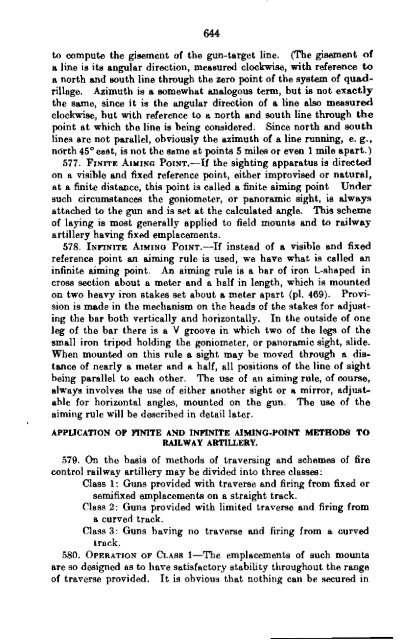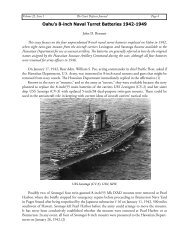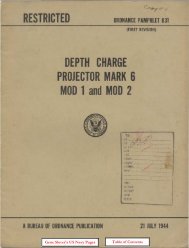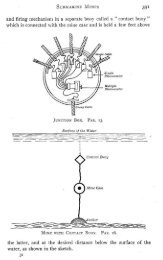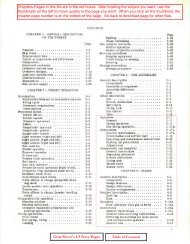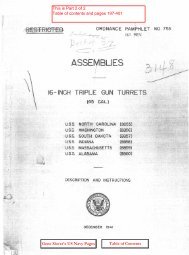...Railway artillery - Personal Page of GENE SLOVER
...Railway artillery - Personal Page of GENE SLOVER
...Railway artillery - Personal Page of GENE SLOVER
Create successful ePaper yourself
Turn your PDF publications into a flip-book with our unique Google optimized e-Paper software.
644<br />
to compute the gisement <strong>of</strong> the gun-target line. (The gisement <strong>of</strong><br />
a line is its angular direction, measured clockwise, with reference to<br />
a north and south line through the zero point <strong>of</strong> the system <strong>of</strong> quadrillage.<br />
Azimuth is a somewhat analogous term, but is not exactly<br />
the same, since it is the angular direction <strong>of</strong> a line also measured<br />
clockwise, but with reference to a north and south line through the<br />
point at which the line is beil.lg considered. Since north and south<br />
lines are not parallel, obviously the azimuth <strong>of</strong> a line running, e. g.,<br />
north 45° east, is not the same at points 5 miles or even I mile apart.)<br />
577. FINITE AIMING POINT.-If the sighting apparatus is directed<br />
on a visible and fixed reference point, either improvised or natural,<br />
at a finite distance, this point is called a finite aiming point Under<br />
such circumstances the goniometer, or panoramic sight, is always<br />
attached to the gun and is set at the calculated angle. This scheme<br />
<strong>of</strong> laying is most generally applied to field mounts and to railway<br />
<strong>artillery</strong> having fixed emplacements.<br />
578. INFINITE AIMING POINT.-If instead <strong>of</strong> a visible and fixed<br />
reference point an aiming rule is used, we have what is called an<br />
infinite aiming point. An aiming rule is a bar <strong>of</strong> iron L-shaped in<br />
cross section about a meter and a half in length, which is mounted<br />
on two heavy iron stakes set about a meter apart (pI. 469). Provision<br />
is made in the mechanism on the heads <strong>of</strong> the stakes for adjusting<br />
the bar both vertically and horizontally. In the outside <strong>of</strong> one<br />
leg <strong>of</strong> the bar there is a V groove in which two <strong>of</strong> the legs <strong>of</strong> the<br />
small iron tripod holding the goniometer, or panoramic sight, slide.<br />
When mounted on this rule a sight may be moved through a distance<br />
<strong>of</strong> nearly a meter and a half, all positions <strong>of</strong> the line <strong>of</strong> sight<br />
being parallel to each other. The use <strong>of</strong> an aiming rule, <strong>of</strong> course,<br />
always involves the use <strong>of</strong> either another sight or a mirror, adjustable<br />
for horizontal angles, mounted on the gun. The use <strong>of</strong> the<br />
aiming rule will be described in detail later.<br />
APPIJCATION OF FINITE AND INFINITE AlMlNG·POINT METHODS TO<br />
RAILWAY ARTILLERY.<br />
579. On the basis <strong>of</strong> methods <strong>of</strong> traversing and schemes <strong>of</strong> fire<br />
control railway <strong>artillery</strong> may be divided into three classes:<br />
Class I: Guns provided with traverse and firing from fixed or<br />
semifixed emplacements on a straight track.<br />
Class 2: Guns provided with limited traverse and firing from<br />
a curved track.<br />
Class 3: Guns having no traverse and firing from a· curved<br />
track.<br />
580. OPERATION OF CLASS I-The emplacements <strong>of</strong> such mounts<br />
are so designed as to have satisfactory stability throughout the range<br />
<strong>of</strong> traverse provided. It is obvious that nothing can be secured in<br />
Digitized by Coogle


